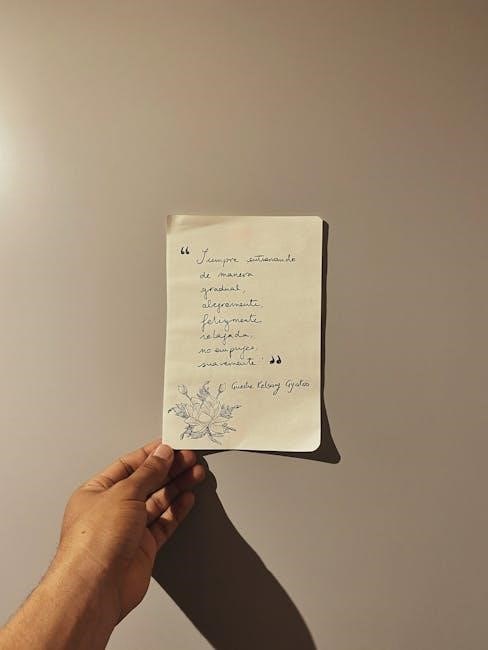“Annabel Lee‚” Edgar Allan Poe’s final poem‚ published posthumously in 1849‚ recounts a tragic love story of youth and loss‚ blending beauty with melancholy and mystery.
1.1 Overview of the Poem
Edgar Allan Poe’s “Annabel Lee” is a hauntingly beautiful narrative poem that tells the tragic tale of a romantic relationship cut short by death. Published posthumously in 1849‚ the poem recounts the love story of the narrator and Annabel Lee‚ set in a mysterious kingdom by the sea. The poem explores themes of love‚ loss‚ and the supernatural‚ blending melancholy with a musical rhythm. Its dreamlike quality and emotional depth have made it one of Poe’s most celebrated works‚ capturing the essence of enduring love and the inevitability of fate.
1.2 Historical Context of the Poem
Published posthumously in 1849‚ “Annabel Lee” was Edgar Allan Poe’s final work‚ released just two days after his death. The poem reflects the tragic circumstances of his life‚ including the loss of his young wife‚ Virginia‚ who died of tuberculosis. Set against the backdrop of 19th-century literary romanticism‚ the poem captures the era’s fascination with love‚ death‚ and the supernatural. Its release during a time of growing interest in Gothic literature further cemented its place in American literary history‚ resonating with readers seeking emotional depth and poetic beauty.
1.3 Significance of the Poem in Poe’s Works
As Edgar Allan Poe’s final poem‚ “Annabel Lee” holds a poignant place in his literary legacy‚ encapsulating his recurring themes of love‚ loss‚ and the mysteries of death. Its lyrical beauty and haunting rhythm reflect Poe’s mastery of evoking deep emotion through language. The poem’s exploration of youthful passion and tragedy resonates with other works like “The Raven‚” showcasing his ability to blend melancholy with artistic brilliance. “Annabel Lee” stands as a testament to Poe’s enduring influence on literature‚ offering a profound meditation on love’s transcendence beyond mortality.
Structure and Style of “Annabel Lee”
The poem features a haunting rhythm‚ with a consistent rhyme scheme and meter that enhances its musical quality‚ typical of Poe’s lyrical style‚ creating a mesmerizing flow.
2.1 Rhyme and Meter in the Poem
Edgar Allan Poe’s “Annabel Lee” features a distinctive rhyme scheme and meter that enhance its musicality. The poem primarily follows an ABABCB pattern‚ with a consistent trochaic meter‚ creating a rhythmic and melodic flow. The refrain‚ repeated at intervals‚ adds to the poem’s haunting beauty. Poe’s use of internal rhyme and alliteration further enriches the auditory experience‚ while the meter underscores the emotional intensity of the narrative. This blend of rhyme and rhythm contributes to the poem’s hypnotic and evocative quality‚ making it a masterpiece of lyrical expression.
2.2 Use of Imagery and Symbolism
In “Annabel Lee‚” Poe masterfully employs imagery and symbolism to evoke a haunting‚ ethereal atmosphere. The “kingdom by the sea” symbolizes a mystical‚ isolated world‚ while the “sepulcher” represents death’s beauty and finality. The moon‚ a recurring symbol‚ signifies eternity and the supernatural‚ tying the lovers’ fate to cosmic forces. These elements create a vivid‚ dreamlike setting‚ enhancing the poem’s emotional depth and themes of love‚ loss‚ and the afterlife. The imagery and symbolism are central to the poem’s enduring allure‚ making it a timeless masterpiece of Gothic literature.
2.3 The Role of Alliteration and Rhythm
In “Annabel Lee‚” Poe masterfully employs alliteration and rhythm to create a haunting‚ musical quality. The repetition of consonant sounds‚ such as “s” and “l‚” enhances the poem’s lyrical flow‚ drawing readers into its dreamlike atmosphere. Rhythm‚ particularly through refrains and meter‚ underscores the emotional intensity‚ making the narrator’s longing and grief resonate deeply. These stylistic elements not only heighten the poem’s beauty but also reinforce its themes of love‚ loss‚ and the ethereal‚ cementing its place as a masterpiece of poetic artistry.
Themes in “Annabel Lee”
The poem explores themes of love‚ loss‚ and the beauty of death‚ intertwined with the supernatural‚ creating a haunting yet enchanting portrayal of eternal devotion and tragedy.
3.1 The Theme of Love and Loss
The poem “Annabel Lee” profoundly explores the theme of love and loss‚ capturing the intense‚ all-consuming passion of young love and its tragic dissolution. The narrator’s enduring devotion to Annabel Lee‚ even after her death‚ underscores the timeless and transcendent nature of their bond. Poe masterfully weaves together the beauty of their love with the sorrow of its loss‚ creating a hauntingly beautiful portrayal of grief. The poem’s emotional depth resonates deeply‚ evoking feelings of both joy and sorrow in its readers.
3.2 The Beauty and Tragedy of Death
In “Annabel Lee‚” Poe masterfully intertwines the beauty of love with the tragedy of death‚ creating a haunting yet mesmerizing portrayal. The poem romanticizes death as a serene and inevitable force‚ with Annabel Lee’s passing symbolizing the loss of innocence and youthful passion. The sepulcher by the sea serves as a poignant reminder of her eternal slumber‚ blending the allure of the unknown with the sorrow of separation. This duality captures the essence of Poe’s fascination with mortality‚ where death is both a tragic end and a transcendent‚ beautiful state.

3.3 The Supernatural and the Mysterious
The poem delves into the supernatural and mysterious‚ evoking a haunting atmosphere. The “kingdom by the sea” and Annabel Lee’s untimely death create an air of enigma. The narrator’s belief that their love transcends death‚ with angels and demons aware of their bond‚ adds a supernatural layer. The sepulcher by the sea and the recurring moon imagery further enhance the mysterious tone‚ suggesting a realm where the living and dead coexist. This blend of mystery and the supernatural captivates readers‚ leaving a lingering sense of awe and intrigue.

Characters in “Annabel Lee”
The narrator‚ often seen as Poe himself‚ mourns his lost love‚ Annabel Lee‚ a beautiful and youthful figure whose tragic death haunts him endlessly.

4.1 The Narrator’s Perspective
The narrator of “Annabel Lee” presents a deeply personal and emotional account of a tragic love story. His perspective is introspective‚ reflecting on the loss of his beloved Annabel Lee with a mix of melancholy and obsession. The narrator’s voice is both intimate and haunting‚ as he recounts their youthful romance and its devastating end. His storytelling is tinged with a sense of inevitability‚ suggesting a profound connection to the events he describes. This perspective underscores the poem’s themes of love‚ loss‚ and the enduring power of memory‚ creating a sense of immediacy and emotional depth.
4.2 The Character of Annabel Lee
Annabel Lee is portrayed as a young‚ beautiful‚ and enigmatic figure‚ embodying innocence and grace. Her character is defined by her deep emotional connection with the narrator‚ highlighting her loving and tender nature. The poem emphasizes her tragic fate‚ as her life is cut short‚ leaving behind a legacy of sorrow and enduring love. Her presence in the narrator’s memory and the afterlife underscores her timeless beauty and the profound impact she had on those who knew her.
Through her character‚ Poe explores themes of youth‚ beauty‚ and the inevitability of loss‚ making Annabel Lee a haunting yet captivating figure in the poem.
4.3 The Relationship Between the Narrator and Annabel Lee
The narrator and Annabel Lee share a deeply romantic and tragic bond‚ rooted in their youthful passion and shared experiences in a mystical kingdom by the sea. Their love is portrayed as pure and all-consuming‚ transcending even death. The narrator’s devotion is unwavering‚ as he reflects on their joy and sorrow‚ emphasizing the enduring nature of their connection. The poem captures the intensity of their relationship‚ blending innocence with profound grief‚ as the narrator clings to memories of Annabel Lee‚ immortalizing their love in his haunting recollections.

Symbolism in “Annabel Lee”
The poem is rich in symbolism‚ with the kingdom by the sea representing a lost paradise‚ while the sepulcher symbolizes death and eternal memory. The moon embodies fleeting beauty and the supernatural‚ tying into themes of love‚ loss‚ and the mysterious.
5.1 The Kingdom by the Sea
The “kingdom by the sea” in “Annabel Lee” symbolizes a mystical‚ isolated realm where the narrator and Annabel Lee’s love unfolds. This enchanting setting‚ with its eerie beauty‚ serves as a backdrop for their tragic tale. The kingdom represents a world apart‚ where love and death intertwine‚ creating a haunting atmosphere. Its isolation mirrors the characters’ fate‚ emphasizing the poem’s themes of love‚ loss‚ and the inescapability of destiny. The kingdom’s imagery evokes both wonder and melancholy‚ reflecting Poe’s mastery of blending beauty with sorrow.
5.2 The Sepulcher
The sepulcher in “Annabel Lee” symbolizes the final resting place of the beloved Annabel Lee‚ emphasizing the tragic end of their youthful love. Situated by the sea‚ it serves as a haunting reminder of her untimely death. The sepulcher represents both death’s inevitability and the enduring bond between the narrator and Annabel Lee. Its presence underscores the poem’s themes of loss and the transcendence of love beyond mortality. The sepulcher’s imagery evokes a sense of melancholy and timelessness‚ bridging the mortal world with the eternal.
5.3 The Moon and Its Significance
The moon in “Annabel Lee” symbolizes the ethereal and timeless nature of love‚ casting a dreamlike glow over the tragic narrative. Its presence evokes a sense of mystery and beauty‚ reflecting the transcendent bond between the narrator and Annabel Lee. The moon’s light often accompanies moments of remembrance‚ emphasizing the enduring quality of their love despite death. This celestial imagery reinforces the poem’s themes of eternity and the supernatural‚ creating a hauntingly romantic atmosphere that lingers long after the poem concludes.

The PDF Version of “Annabel Lee”
The PDF version of “Annabel Lee” offers a convenient and readable format‚ preserving Poe’s original text while enhancing accessibility for modern readers and scholars alike;
6.1 Features of the PDF Edition
The PDF edition of Annabel Lee offers a clean‚ readable format‚ preserving the poem’s original beauty. It includes annotations and historical context‚ enhancing understanding. The PDF is accessible on various devices‚ ensuring convenience. With its timeless themes‚ the poem remains a cherished read‚ and the PDF format makes it easily shareable and printable. This edition is ideal for both casual readers and scholars‚ providing a seamless way to engage with Poe’s masterpiece.
6.2 Where to Find the PDF Online
The PDF version of “Annabel Lee” can be easily found on various online platforms. Websites like Google Books‚ Project Gutenberg‚ and academic databases offer free access to the poem in PDF format. Additionally‚ many library websites and online archives provide downloadable versions for readers. Some platforms may require registration or institutional access‚ but the poem is widely available due to its public domain status. Searching for “Annabel Lee PDF” on popular search engines will yield multiple reliable sources for download.
6.3 Benefits of Reading the PDF Version
Reading the PDF version of “Annabel Lee” offers a seamless and immersive experience. The formatted text preserves Poe’s original structure‚ enhancing readability. The PDF is accessible on multiple devices‚ allowing readers to enjoy the poem anywhere. Additionally‚ many PDF editions include annotations‚ historical context‚ and illustrations‚ deepening the understanding of Poe’s masterpiece. The digital format also enables easy navigation‚ making it ideal for academic or personal study. Overall‚ the PDF version provides convenience‚ clarity‚ and enhanced engagement with the poem’s haunting beauty and profound themes.

Analysis of the Poem
Critics interpret “Annabel Lee” as a haunting exploration of love‚ loss‚ and memory‚ reflecting Poe’s mastery of tragic beauty and emotional depth in his final work.
7.1 Critical Interpretations

Critics often interpret “Annabel Lee” as a poignant reflection of Poe’s personal tragedies‚ with its themes of love‚ loss‚ and the supernatural resonating deeply. The poem’s haunting beauty and melancholic tone are seen as masterful expressions of grief‚ while its dreamlike imagery invites psychological exploration. Scholars note how the narrator’s obsessive memory of Annabel Lee blurs reality and fantasy‚ suggesting a complex interplay between love and mourning. The poem’s lyrical simplicity contrasts with its profound emotional depth‚ making it a subject of enduring literary analysis and admiration.
7.2 Psychological Insights
The poem offers profound psychological insights into grief‚ obsession‚ and the human psyche. The narrator’s enduring love for Annabel Lee reflects a deep-seated longing and inability to let go‚ suggesting unresolved trauma. The interplay between beauty and death explores the mind’s struggle to reconcile joy with loss. Freudian interpretations might view the narrator’s fixation as an Oedipal complex or a manifestation of subconscious desires. The kingdom by the sea symbolizes a lost paradise‚ while the moon represents the cyclical nature of life and death‚ echoing the narrator’s eternal‚ haunting memories of Annabel Lee.
7.3 Cultural and Historical Relevance
Published posthumously in 1849‚ “Annabel Lee” reflects the Victorian era’s fascination with death and mourning. Its themes of love‚ loss‚ and the afterlife resonated deeply with mid-19th-century American culture. The poem’s romanticism and gothic elements align with the literary trends of its time‚ while its exploration of youthful tragedy mirrored societal anxieties about mortality. As one of Poe’s final works‚ it holds historical significance‚ offering insights into his evolving style and emotional depth. The poem’s enduring popularity underscores its cultural impact‚ influencing later writers and artists while remaining a timeless reflection of universal human experiences.
The Legacy of “Annabel Lee”
“Annabel Lee” has left an enduring mark on literature‚ inspiring countless adaptations in music‚ film‚ and art‚ while remaining a timeless classic in American poetry.
8.1 Impact on Literature
Edgar Allan Poe’s “Annabel Lee” has left an indelible mark on literature‚ influencing countless writers and poets with its haunting beauty and emotional depth. Its exploration of love‚ loss‚ and death resonated deeply‚ shaping the Gothic and Romantic movements. The poem’s lyrical style and themes of longing have inspired generations‚ making it a cornerstone of American literary heritage. Its enduring popularity‚ even in PDF formats‚ ensures its influence continues to ripple through modern literature and poetry.
The poem’s ability to evoke profound emotion and its masterful use of language have made it a timeless classic‚ inspiring writers to explore similar themes and styles. Its legacy endures‚ cementing Poe’s place as a literary giant.
8.2 Influence on Other Artists and Writers
Edgar Allan Poe’s “Annabel Lee” has profoundly influenced numerous artists and writers‚ inspiring works across literature‚ music‚ and film. Its haunting beauty and tragic themes have captivated creators like Charles Baudelaire‚ who translated Poe’s works into French‚ and H.P. Lovecraft‚ who drew inspiration from Poe’s atmospheric style. Musicians‚ such as Stevie Nicks‚ have referenced the poem in their songs‚ while filmmakers have adapted its themes into movies. The poem’s ethereal and melancholic tone continues to resonate‚ making it a timeless source of creative inspiration for artists worldwide.
8.3 Popular Culture References
Edgar Allan Poe’s “Annabel Lee” has inspired countless references in popular culture‚ from music to film and literature. The poem’s haunting beauty and tragic themes have influenced artists like Stevie Nicks‚ who wrote a song inspired by its narrative. Similarly‚ the poem has been referenced in movies‚ such as The Haunted Palace‚ and in literary works that explore love and loss. Its imagery‚ particularly the “kingdom by the sea‚” has become iconic‚ resonating with audiences across generations. The poem’s enduring appeal ensures its continued influence in modern media and creative expression.

“Annabel Lee” stands as a timeless masterpiece‚ capturing the essence of love‚ loss‚ and beauty. Its haunting beauty resonates deeply‚ ensuring its enduring appeal and relevance. Available in PDF‚ it remains accessible to readers‚ preserving Poe’s poignant legacy.

9.1 Summary of Key Points
Edgar Allan Poe’s “Annabel Lee” is a poignant tale of love and loss‚ exploring themes of beauty‚ tragedy‚ and the supernatural. Published posthumously in 1849‚ the poem reflects Poe’s mastery of rhyme‚ rhythm‚ and imagery. Its haunting narrative captures the enduring bond between the narrator and Annabel Lee‚ even after her untimely death. The poem’s dreamlike quality and emotional depth resonate deeply‚ making it a cornerstone of Poe’s legacy. Its exploration of love’s transcendence and death’s mystery continues to captivate readers‚ solidifying its place in literary history.
9.2 Final Thoughts on the Poem’s Significance
Edgar Allan Poe’s “Annabel Lee” remains a timeless masterpiece‚ captivating readers with its haunting beauty and profound exploration of love‚ loss‚ and memory. Its enduring appeal lies in its universal themes‚ evocative imagery‚ and the emotional resonance of its tragic narrative. As Poe’s final work‚ it serves as a poignant farewell‚ showcasing his mastery of language and depth of feeling. The poem’s accessibility in PDF format ensures its continued relevance‚ allowing modern readers to connect with its timeless essence and reflect on the beauty of fleeting life and eternal love.

